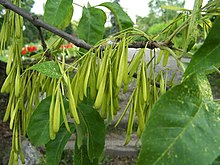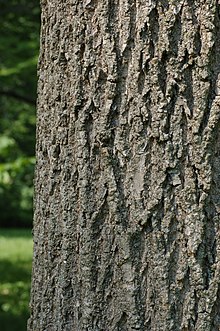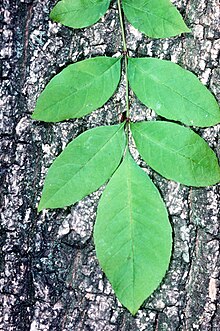Fraxinus pennsylvanica
| Fraxinus pennsylvanica | |
|---|---|

| |
| Leaves and fruit | |
| Scientific classification | |
| Kingdom: | Plantae |
| Clade: | Tracheophytes |
| Clade: | Angiosperms |
| Clade: | Eudicots |
| Clade: | Asterids |
| Order: | Lamiales |
| Family: | Oleaceae |
| Genus: | Fraxinus |
| Section: | Fraxinus sect. Melioides |
| Species: | F. pennsylvanica
|
| Binomial name | |
| Fraxinus pennsylvanica | |

| |
| Natural range of Fraxinus pennsylvanica | |
Fraxinus pennsylvanica, the green ash or red ash,
Other names more rarely used include downy ash, swamp ash, and water ash.
Description

Fraxinus pennsylvanica is a medium-sized
It is sometimes divided into two
Like other species in the section Melioides, Fraxinus pennsylvanica is
Ecology
This section needs additional citations for verification. (July 2021) |

It is the most widely distributed of all the American ashes; its range centers on the midwestern U.S. and Great Plains. Seedlings of the tree have a high tolerance to water logging[12] which may explain why the natural habitat of green ash is almost exclusively stream sides and bottomlands. The large seed crops provide food to many kinds of wildlife.[3]
Green ash is threatened by the
The United States Forest Service has discovered small numbers of "lingering ash" trees in the wild that have remained healthy after emerald ash borer swept through the population.[16] The possibility of these trees possessing genetic resistance to the beetle is currently being investigated with the hope that green ash could be restored using the surviving trees.[17] Although larval infestation by the invasive emerald ash borer kills more 99% of green ash trees, it has been found that emerald ash borer infestation induces production of secoiridoids in infested trees and that cultivars that are progeny of "lingering ash" produce higher levels of these secoiridoids than progeny of susceptible trees.[18]
The spread of emerald ash borer was facilitated by the extensive use of green ash as an ornamental tree in the central U.S. following the loss of
Injections and spraying of ashes with pesticides has been used in city parks to protect valued trees from emerald ash borer.[20]
Record cold temperatures during the winter of 2018–19 are estimated to have killed as much as 80% of ash borer larvae in the Upper Midwest.[21]
Both American elm and green ash were extremely popular due to rapid growth and tolerance of urban pollution and road salt, so many housing developments in Michigan were lined from end to end with ashes, a result of which the beetles had an enormous food supply to boost their population well above Infestation thresholds. The tree was also extensively propagated and sold by local nurseries. According to the American Nursery Industry, "Back in the late 1980s, Dr. Frank Santamour Jr., then a research geneticist with the U.S. National Arboretum, proposed the 10-20-30 formula for diversity in the urban forest, limiting the plantings in a community to no more than 10 percent within a single species, 20 percent within a genus and 30 percent within a family." Many communities are using a more strict 5-10-20 rule today, because of the threat posed by emerald ash borer.
The emerald ash borer proved to be a far worse and potentially more serious threat than epidemics of the past such as chestnut blight and Dutch elm disease because those diseases spread at a slower rate, only affected one species, and did not kill the trees before they could attain reproductive maturity. Many areas have banned the sale of ash seedlings in nurseries, although seeds may be sold as they are not a vector for the insect.
Green ash is also vulnerable to many other diseases including
Uses
This section needs additional citations for verification. (July 2015) |
Urban ornamental trees

Green ash is one of the most widely planted
For the last two centuries
Other continents learned of American ash species' urban survivability and unique beauty through the worldwide popularity of Midwestern Prairie style ecology and architectural movement. Modernizing cities in Russia and China then began using imported green ash a century ago to line streets and landscape new public parks.[25][26] Advantages of green ash include its tolerance of harsh urban environmental conditions, ease of propagation, and (in eastern North America) its value for wildlife as a native keystone species.[27]
Utility to wildlife
North American native ash tree species are used by North American frogs as a critical food source, as the leaves that fall from the trees are particularly suitable for tadpoles to feed upon in ponds (both temporary and permanent), large puddles, and other water sources.[28] Species such as red maple, which are taking the place of ash due to the ash borer, are much less suitable for the frogs as a food source — resulting in poor frog survival rates and small frog sizes.[28] It is the lack of tannins in the American ash varieties that makes them good for the frogs as a food source and also not resistant to the ash borer. Varieties of ash from outside North America typically have much higher tannin levels and resist the borer. Maples and various non-native invasive trees, trees that are taking the place of American ash species in the North American ecosystem, typically have much higher leaf tannin levels.[28]
Other uses
Green ash
use ash in the construction of their guitars.References
- . Retrieved 12 November 2021.
- ^ NatureServe (2 February 2024). "Fraxinus pennsylvanica". NatureServe Network Biodiversity Location Data accessed through NatureServe Explorer. Arlington, Virginia: NatureServe. Retrieved 7 February 2024.
- ^ a b Kennedy Jr., Harvey E. (1990). "Fraxinus pennsylvanica". In Burns, Russell M.; Honkala, Barbara H. (eds.). Hardwoods. Silvics of North America. Vol. 2. Washington, D.C.: United States Forest Service (USFS), United States Department of Agriculture (USDA) – via Southern Research Station.
- ^ a b "Fraxinus pennsylvanica". Germplasm Resources Information Network. Agricultural Research Service, United States Department of Agriculture.
- ^ "Fraxinus pennsylvanica". World Checklist of Selected Plant Families (WCSP). Royal Botanic Gardens, Kew.
- ^ "Fraxinus pennsylvanica". County-level distribution map from the North American Plant Atlas (NAPA). Biota of North America Program (BONAP). 2014.
- ^ Common Trees of the North Carolina Piedmont: Fraxinus pennsylvanica
- ^ Northern Ontario Plant Database: Fraxinus pennsylvanica
- ^ Virtual Herbarium of the Chicago Region: Fraxinus pennsylvanica Archived 2007-08-13 at the Wayback Machine
- ^ Oklahoma Biological Survey: Fraxinus pennsylvanica
- S2CID 24152294.
- .
- .
- ^ Emerald ash borer: EAB website
- PMID 18348816.
- ^ Knight, Kathleen S.; et al. (2012). "Dynamics of surviving ash (Fraxinus spp.) populations in areas long infested by emerald ash borer (Agrilus planipennis)". Proceedings of the Fourth International Workshop on the Genetics of Host-parasite Interactions in Forestry: Disease and Insect Resistance in Forest Trees: 143–152.
- S2CID 15947102.
- .
- ^ "Fraxinus comparison chart". www.uwgb.edu. Retrieved 2018-11-11.
- ^ "Injecting ash trees to protect from emerald ash borer". 6 July 2017.
- ^ "One benefit of Minnesota's polar plunge: Ash borers took a licking". 31 January 2019.
- ^ Edmonton: trees Archived 2007-09-27 at the Wayback Machine
- OCLC 1141235469.
- ^ Cook, Bill. "Forest management guidelines for Michigan". Michigan SAF Home Page. Michigan Society of American Foresters. Retrieved 5 July 2015.
- S2CID 54088956.
- ISSN 1297-966X.
- ^ "Ash Tree Identification". New York Invasive Species Information. Cornell University Cooperative Extension. Retrieved 5 July 2015.
- ^ .


